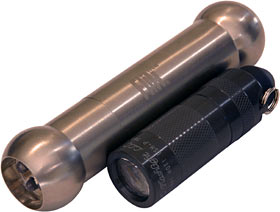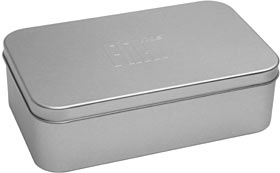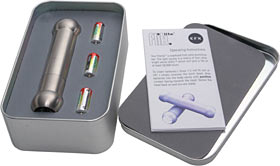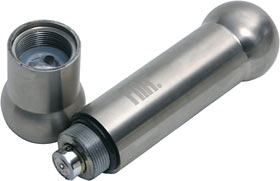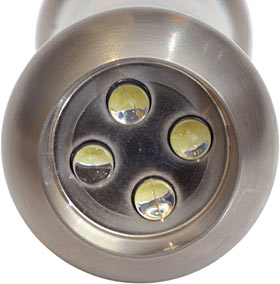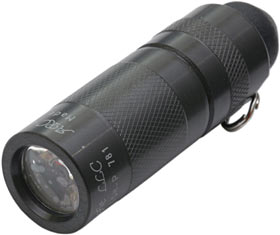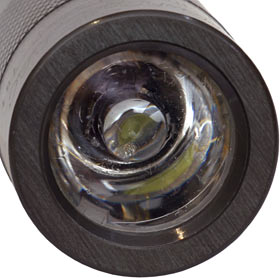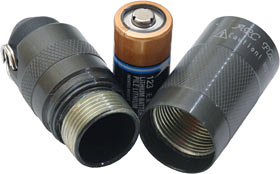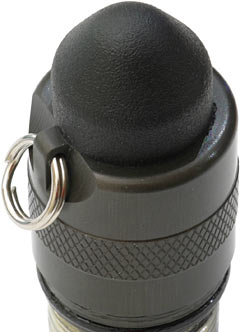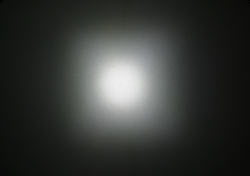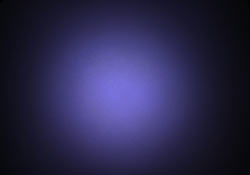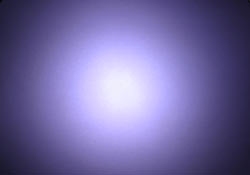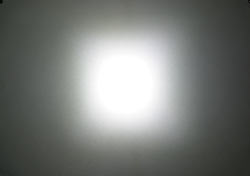
Fliklite and Arc-LS LED flashlights
Review date: 21 June 2003.Last modified 03-Dec-2011.
If the only flashlights you'd ever consider buying cost a few bucks and are sold in supermarkets, then these two products are unlikely to be very interesting to you.
The sleek little barbell on top is a Fliklite. Yours for ŁUK39.95 plus shipping, from the manufacturer's online store. That's about $US67, as I write this, or about a hundred of the colourful little things we Australians are pleased to call dollars. US shoppers can save a bit of money if they buy one here, and save a bit more if they buy one here.
The Fliklite's 123mm (4.8 inch) long body weighs a surprisingly hefty 169 grams (six ounces), with batteries installed; that's because pretty much every part of this thing that isn't batteries or lamp is solid machined aluminium. Well, except for the extremely gadgetty switch, but I'll get to that in a moment.
The smaller, darker, meaner looking light is an Arc-LSH Premium, the best, brightest and most expensive of Arc Flashlight's current flagship Arc-LS models. Less than 80mm long and weighing a hair over 60 grams (2.2 ounces) with battery, it'll fit in a pleasingly un-noticeable way in the little Zippo pocket of a pair of jeans.
It's yours for a mere $US160.
(Well, it was when you could buy it, anyway. A bit more than a year after I wrote this review, Arc Flashlight went broke.)
While you're getting your breath back about that, let's have a look at the cheaper light, shall we?
Give 'em the Flik
The Fliklite company doesn't make a secret of their target market - on their home page it says that this is "the lighting gadget that makes a great gift".
When something's described, right there on the label, as a "gadget", your expectations concerning its practicality should be limited. "Gadget" is Man Code for "toy".
Now, toys may be capable of doing surprisingly advanced things, but the principal purpose of a gift-gadget is making the first-time user say "Oh! Cool!".
We're in ludicrously illegible timepiece territory, here. Usability is optional.
The Fliklite passes the "Oh! Cool!" test with flying colours, thanks to its switch.
You turn the Fliklite on by flicking it downwards, while holding the tail end, as if you were trying to shake water off the lamp end. Flick the light firmly - or tap it lamp-first on a surface - and it turns on. Tap it butt-first on a surface and it turns off again. There's a little moving part inside the lamp that does the job, and it does it well, and quite reliably - though if you turn the light off with a gentle tap, it'll be more prone to turning on when tapped slightly in the other direction.
When turned off solidly, the Fliklite will turn on again when dropped an inch and a half onto a hard surface.
The nifty switch design allows this light to be solidly sealed, and it's alleged to be waterproof to 30 metres. The flick-switch also, however, means that this light can easily turn on when you drop it, or even when it's bouncing around inside a bag.
The Fliklite further enhances its gadget-gift value with snazzy packaging.
It comes in this shiny tin...
...within which is one Fliklite, one small instruction sheet, and three surprisingly teeny batteries.
The batteries are N-sized alkalines.
N cells aren't big. They don't have a whole lot of capacity. They don't like being discharged hard. This isn't good.
Humble AAA alkalines beat Ns by a bit for capacity and by a lot for current delivery capability. A brand name N cell will have about one amp hour (Ah) nominal capacity versus about 1.25Ah for a AAA, which looks OK. But if you ask for 200 milliamps (mA) of current from an N alkaline, it'll only survive for a couple of hours before slumping from its nominal 1.5 volts per cell to 0.8V, at which point it's pretty much completely toast. A decent AAA cell in the same situation will last around four hours; a quality AA cell will last about ten hours.
The Fliklite lamp contains four 5mm high intensity white LEDs, mounted in a recess in the front bulb of the light's body, which should protect them from damage very well.
Three-cell LED flashlights with four 5mm LEDs can be expected to draw at least 120mA, and commonly more than 200mA. So N cells would not be my first choice to power such a device.
Because this is an LED light, though, its battery life can be expected to be excellent, provided you don't mind it getting rather dim. White LEDs aren't actually incredibly efficient lighting devices compared with filament lamps, but they work far, far better from weak batteries than an incandescent bulb will. So you can use pretty much the entire capacity of your flashlight's batteries, as long as you're happy with a flashlight that emits rather less light than it did when the batteries were fresh.
In use, the Fliklite is undeniably an excellent gadget. The flick-switch works beautifully, the light feels good in your hand, and it's unquestionably very solidly made. Ridiculously so, in fact; it is entirely unsurprising that it survived being run over by a tank (video clip here). Apparently three times, on frozen ground, at that!
So yes, this light is just stupidly strong. I doubt anybody's ever going to suffer a mishap that'll break a Fliklite but leave the owner alive.
Arcing over
The Arc-LS is such a tiny light because it's powered by a lithium 123-size battery, as used in many cameras. 123 batteries are also used in a lot of other butch little lights, because they're quite readily available, small and light, have decent capacity, last forever on the shelf, and can deliver quite a lot of current.
According to the PDF-format spec sheet here, an Energizer 123 can be expected to deliver one amp for 51 minutes before sagging to only 2V from its nominal 3V; it's rated for 1.5A continuous discharge, and 3.5A pulse. This means a two-cell 123-powered light that's used for occasional alleged-perpetrator-blinding bursts can support a bulb with 15 to 20 watt output - which is pretty darn amazing for something that's not much bigger than a 2-AA-cell penlight.
The Arc-LS isn't nearly that mean to its single 123, because its lamp uses a one watt Luxeon Star super-LED. One watt is the nominal rating for this lamp; it's happy running at less than that, and can also manage a bit more if it's well enough cooled. As is normal for LEDs, the Star has an enormous life expectancy; if it's not overdriven, this light's lamp will almost certainly outlive its owner.
This "Arc-LSH" has the H on its name because it uses a "high dome" Luxeon LED, with a "Lambertian" radiation pattern. In English, that means the optics in front of the LED die can focus its light to an unusually tight beam, by LED flashlight standards. The Fliklite casts a wide, smooth pool of light, like most LED flashlights; the Arc-LSH has a much more noticeable central hot spot.
There's plenty of splash light around the LS's central spot, though, so the Arc-LSH is still useful for close-up wide-angle tasks, like seeing where you're walking at night. There's also an "Arc-LSL" model with a low-dome LED, which has a wider beam.
The LSH is unusually handy, by LED standards, for seeing things at a distance; it can't compete with a cheap big-reflector lantern from the supermarket for real spot-beam performance, but it'll show you what's at the top of most trees quite successfully.
One 123 cell comes with the Arc-LS (as you'd bleeding well want it to, for the money), and the body of the light has a tight thread that makes it waterproof to 50 feet. At that depth, I think the pushbutton switch might well be pushed all the time by water pressure; pushbuttons don't work under much water. But at least the light won't drown.
Above sea level, the switch is great. It's the kind of switch you get on the "tactical" burst-use lights I mentioned above; you can press it lightly for momentary operation, or click it in to lock the light on. The switch's rubber cover also gives you something other than hard-anodised aluminium to bite down on, if you're holding the Arc-LS in your mouth to keep your hands free. This light's small enough that you can hold it in your lips comfortably enough, though. You don't have to be a performer in specialised DVD productions for a select and discerning audience to get your mouth around it.
The original incarnation of the Arc-LS didn't have a switch on the end. It used the tried and tested twist-switch design, where you turn the head of the light to tighten it down onto its battery and complete the circuit. Unfortunately, that older LS lacked a spring-loaded contact for the negative end of the battery; it just had a little peg. This meant that you could easily squish the battery when you turned the light on.
This problem has been solved in the current tail-switch-equipped LS; it doesn't have a twist switch, and it also has a traditional conical spring contact inside.
I got the standard 123-cell version of the Arc-LS, but there's also an optional longer battery compartment that accepts two AA cells; it's $US39.95. You can buy Arc-LS heads and battery compartments separately, so you don't have to buy a 123-cell tail for your flashlight if you don't want one.
The Arc-LS, by the way, is also capable of turning on when you drop it, though it has to hit pretty much perfectly switch-end-down to do more than just flash for a moment. A straight-down four inch drop onto a hard surface was enough to turn on my review light.
Power
Every time I turned the Fliklite on, I found myself imagining tiny screams of agony from its batteries. It's quite a bright light for a four-5mm-LED unit, so I figured the fresh N cells were probably copping a serious beating.
I was right.
The Fliklite sucked its three new N cells, totalling 4.55V unloaded, down to 3.8V. Its current draw started out below 400mA, but when I gave it several seconds to warm up, it drew 600mA and beyond, when running at 3.8 volts from my bench power supply.
This is ordinary LED behaviour, when they're not held back by current limiting circuitry; it would appear that the Fliklite has its LEDs wired in parallel and running straight from the three series-wired batteries, so they're doing their best to go into thermal runaway and are restrained only by the rather high internal resistance of the N cells.
600mA split between only four LEDs is pretty horrendously high. The poor things seem to be running at five times their rated 30mA maximum current; I used to think an overdrive factor of only three was cruel and unusual. But the Fliklite's presumably sinking the heat from the overdriven LEDs into its massive metal body, so they ought to survive pretty well.
Their life will be extended by the fact that the N cells will run out of puff really quickly at this power level. I was watching the supply voltage tick down by the second when I was running the lamp from its batteries; it's virtually a keyring light, as far as battery abuse goes.
The weaker the N cells get, though, the less voltage they'll have, and the less voltage they have, the less current the lamp will draw. A constant 600mA load is right off the edge of the performance envelope in the Energizer N cell data sheet (in PDF format here), but the voltage/current graph for the Fliklite lamp is quite nicely logarithmic; it won't be drawing 600mAS for long. At 3.8 volts, the Fliklite behaves like a 6.3 ohm resistive load, but at 2.8 volts, it's still outputting better-than-nothing light but behaving more like a 140 ohm resistor. The 2.8 volt current draw is barely two milliamps!
With a 6.3 ohm load across three N cells, you can expect less than a quarter of an hour of service even allowing for the low voltage tolerance of LEDs. A 140 ohm load, though, can be expected to give about 36 hours of service. So the Fliklite people's claim of 20 hour battery life sounds fair enough to me.
As is common among LED light makers, they're not telling you that your light's going to be a huge amount dimmer at the end of that 20 hours than it was at the start. But if you're not bothered about that, then it's a fair claim.
Incidentally, you can get 150 milliamp-hour N-size nickel cadmium (NiCd) rechargeable cells. If you used three of those in a Fliklite, it'd get something close to a nice clean 3.6 volts for practically the whole battery life, and draw a constant 300-odd milliamps, which would give you a neat half-hour run time. NiCds go flat fast on the shelf (so do nickel metal hydride rechargeables), and half an hour is a pretty miserable life, but this'd be half an hour at close to full brightness, which might be handy. Ordinary consumer NiCd chargers aren't likely to accept N cells, though.
The Arc-LS has a better power supply. As, once again, you'd want it to, for the money.
The Arc's 123 cell has a lot more current capacity than a string of N cells - so would a couple of AAs in the alternative Arc-LS battery holder, for that matter - and this light isn't a simple series-circuit unit. It's got a DC-to-DC converter in it that boosts the output of a dying battery to keep the lamp power close to maximum - "sun mode" - for almost the whole battery life. Then it drops to a low power "moon mode" when the battery's almost dead.
The Arc's rated for about a two hour sun mode run time from a 123 (user reports say you're likely to get about 130 minutes from big-brand 123 cells, and about 110 minutes from decent off-brand cells that cost half as much...), plus maybe 20 more hours of far dimmer moon mode operation. My own multimeter-and-power-supply fiddling supports that claim.
Output
You gaze, mortal, upon the beam of the Arc-LSH-P, shining at an A3 sheet of white paper, hanging horizontally 50cm from my ISO 100, f3.5 camera, and photographed with a 1/30th of a second shutter speed.
(Yes, I will attempt to connect these statistics to the real world in just a moment. Relax.)
The central beam spot looks rather square, because the die of the Luxeon Star LED is square, and its optics project that shape forward.
The light also looks very, very white, because it is. I set the camera's white balance to match the output of the Arc-LSH-P, but it really does have pretty darn white output; not yellow-white like incandescent, not blue-white like many LED flashlights, not green-white like many fluorescent tubes and some LED lights. White-white, about as untinted as it gets.
You can expect light this nice from all of the Premium Arc-LS models; you shouldn't be surprised if the cheaper models have a slight colour cast. They'll also probably be dimmer, though not awfully so; the Premium lights get "P" and "Q" rank high-class factory-racing-team LEDs, and the others get the mainstream LEDs.
(I talk more about LED "ranks", by the way, in this letters column. Note that Nichia call their worst LEDs "Q rank"; Lumileds, makers of the Luxeon LEDs, don't use the same system. Their "Q" LEDs are good ones.)
Here's the Fliklite's output, at the same 1/30th second exposure. It looks very blue, but it isn't really that bad; it's just got the standard bluish-white LED output. Blue-white light is actually quite pleasant, if you ask me.
Here's a 1/8th second exposure, which makes the Fliklite output look about as bright as the Arc-LS's in the middle of the beam, and makes it look as if it's got considerably more output overall. It hasn't, of course; this exposure is 3.75 times longer, and the Fliklite's output will drop rapidly as its batteries age.
From fresh batteries, though, the Fliklite doesn't lose to the Arc by an enormous amount.
Here's the Arc-LS output at 1/8th second. The middle of the beam is now seriously overexposed.
And here, for comparison, is the illumination of the same target by the 50cm fluorescent tube that lights my office. It's lighting the paper rather obliquely from a metre and a half away.
The fluoro's output looks so yellow mainly because its plastic diffuser is not at all new. Without the diffuser, it's actually pretty white, because it's not a super-high-efficiency greenish tube.
The fluoro provides perfectly acceptable, read-a-newspaper-by-it, night-time illumination for my office - but the above shot is a one second exposure. At 1/30th, it's a bit hard to tell whether the light's on at all.
What this means is that these two flashlights are both very respectably bright for their size. And the Arc-LS will stay that way, for a couple of straight hours.
Overall
The Fliklite is a gadget. It's a good gadget. It's even a useful gadget. But it's not a completely practical product. Its batteries are too small, and its funky switch is too easy to turn on by mistake.
If you keep your Fliklite on a shelf, then it won't turn itself on by accident unless something knocks it off. But if you carry it around all the time - and it's such a neat thing that you may well want to - then it'll probably misfire quite often.
The Fliklite's weeny little N cells won't last long if the light goes off while it's sitting in your briefcase or backpack. If you want to put it in your car's glovebox, you'd better pack other stuff around it so it can't slide.
There's a Luxeon Star version of the Fliklite on the way, using lithium batteries. If those batteries are a couple of lithium AAs, then the battery life problem ought to be greatly reduced, considering the rather brighter output the light also ought to have. So I'll keep an eye out for the new model.
With the above caveats, I can recommend the N-cell Fliklite, for its intended purpose. If you need a gift for The Person (Oh, Let's Face It, Probably The Man) Who Has Practically Everything But Not A Light You Flick To Turn It On, then the Fliklite is a resounding success.
It's just not, well, terribly serious.
The Arc-LS is serious. It's a rock-solid bullet-proof well-thought-out device that's probably the most effective tiny-light you can buy if you get it with the 123 battery pack, and that's unquestionably the King Of The Penlights if you get it with the AA-cell pack. It's thrillingly expensive, yes, but if you amortise the price over the multiple decades that this thing could plausibly last, then the price really doesn't seem that bad.
The Arc-LS is the kind of light that people who can field-strip a chain-fed grenade launcher in the dark, but would prefer not to, use. It has secret-agent-paratroop-frogman-Man-In-Black written all over it, and that's not just indicative of successful marketing; people who do Very Scary Things for a living would be well pleased with an Arc-LS.
If quality gizmoes appeal to you, then to touch an Arc-LS is to want one. But, as I mentioned above, you can't have one any more; Arc are no more.
Just for your information, though, there was also a an almost-as-bright non-Premium Arc-LSH for only (!) $US130. The wider-beam Arc-LSL was ten bucks cheaper, for both Premium and non-Premium versions.
The Arc store also had a closeouts, seconds and specials department, where you could get a factory second Arc-LS for $US60. That was practically affordable, that was.
Fliklite kindly provided by Fliklite. Available in the UK from EFX, and in the USA from Lifestyle Fascination and Pocketlights.com.
Arc-LS kindly provided by
Arc Flashlight.
(who went
out of business, but are back now)
